With the coronavirus currently raging around the world and no end to the health crisis in sight, expect to see an increase in these sort of hypothetical think-pieces from my blog.
This is something I feel like I should have written about ages ago. But now, while we wait for production on Amazon’s The Lord Of The Rings streaming series to resume, we have to wonder: what will the series actually be about? Hint: it’s not The Lord Of The Rings – or, rather, it is, but not quite in the way you were probably expecting, if you haven’t been following along with every tidbit of news about the series.
You see, while Amazon Prime does have the rights to J.R.R. Tolkien’s most well-known and influential novel, that’s not what they’re choosing to adapt in their billion-dollar, five-season production. Instead, they’re rummaging around in the depths of Tolkien lore, in a little-known and oft-overlooked period of Middle-earth history: a time period known as the Second Age. The average audience member introduced to the Tolkien fandom through Peter Jackson’s movies probably doesn’t know this term, but they do know two major events that happened in the Second Age – namely, the forging of the One Ring, and the first defeat of Sauron the Dark Lord. Both events happened in rapid succession in the prologue to The Fellowship Of The Ring, but in Tolkien’s timeline there are more than a thousand years between those two things.
That’s why today we’ll be looking at ten events that shaped the Second Age and will likely define the series.
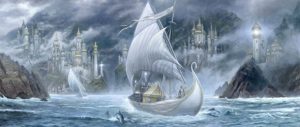
10: Rebuilding After The First Age. Amazon Prime does not have the rights to adapt material from J.R.R. Tolkien’s posthumously published The Silmarillion, meaning they probably won’t be addressing too many events from the First Age of Middle-earth’s history, at least not in great detail. But they don’t really need to: the Second Age picks up right where the First left off, with all of Arda (basically, the entire world, of which Middle-earth is actually only a small piece) in ruins following the fall of Morgoth the Accursed and the destruction visited upon the earth’s surface by the trampling feet of the host of the Valar (Middle-earth’s pantheon of gods). Continents get pushed around, coastlines change, mountains crumble – just an average day in Arda. Assuming the series starts roughly around the beginning of the Second Age, it’ll have to cover several events that happen here: the migrations of Elves, Men and Dwarves across Middle-earth, the foundations of new cities and strongholds, and the establishment of empires such as Númenor, a star-shaped island kingdom given as a gift to Mankind by the Valar; Lindon, which becomes the chief dwelling-place of the High Elves under the rule of King Gil-galad; and Eregion, a small but hugely influential kingdom settled by Celebrimbor, last of the crafty Fëanorian Elves. Even if the series starts later in the Second Age, these events will still probably be covered in flashbacks.
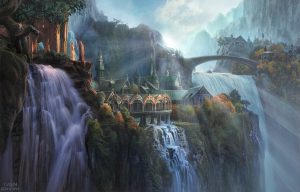
9: The Heyday Of Elves And Men. This is the time period during which we can probably expect a large part of the series to take place. Basically, what you need to remember about the Elves we’ll see living in Second Age in Middle-earth is that they chose to stay there. After the First Age, when the world was remade and Morgoth was undone, the Elves were offered a choice by the Valar: to repent for all their sins (which included killing some of their brethren and defying the will of the Valar) and return to the Blessed Realm of Valinor across the Western Sea, or to remain in Middle-earth. Some chose to head back home, but a lot decided to stay: the ones who stayed grew arrogant, and tried to prove to the Valar, in a way, that they could make Middle-earth just as blissful and peaceful as Valinor. This motivated Celebrimbor to welcome a stranger who came among his people claiming to be an emissary from the Valar who had taken pity on the Elves of Middle-earth. This stranger, going by the name of Annatar, Giver of Gifts, was welcomed into the kingdom of Eregion and quickly rose to power there. Meanwhile, in Númenor, human Men began to sail far and wide across the seas of Arda, settling in colonies along the coasts of Middle-earth and venturing even to the edge of the world. Something else to remember, for future reference: at this point in the timeline, the earth is flat. A flat, roughly circular disc just floating in the cosmos, minding its own business. So when I say the Númenóreans ventured to the edge of the world….I mean that literally.
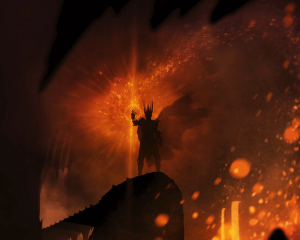
8: The Rings Of Power. Remember that stranger who showed up in Eregion? Yeah, well, it’s at this point in the timeline that he basically comes out and says what every Elf in Middle-earth has already been feeling: it’s time to radically redesign the balance of power in Arda. He and Celebrimbor work together to forge a set of Rings, each of which is imbued with terrible power. These Rings are given out to all the major players in Middle-earth: King Gil-galad gets one, Círdan the Shipwright gets one, the Lady Galadriel gets one; seven Dwarf-lord get one each; nine of the most powerful human sorcerers, kings and warriors get one each. But in secret, Annatar, Giver of Gifts, has been stealing Celebrimbor’s secrets to forge his own Ring – a master Ring, a Ring that will rule all the other Rings and bind them to his will. Oh wait, did I forget to mention that Annatar is actually Sauron the Dark Lord in disguise? Yeah, he totally is, and he’s intent on getting vengeance on the Valar for what they did to Morgoth, his master and mentor in the First Age. But when he puts on his One Ring and declares himself to be the Lord of the Rings, Celebrimbor senses his true purpose and hides all the other Rings, buying himself a little time.
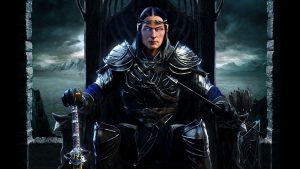
7: The War Of The Elves And Sauron. Unfortunately for Celebrimbor, his quick action meant that the Three Rings given to the Elves were saved – but he himself was captured by Sauron during an attack on Eregion, tortured for that information until he died of exhaustion, and then was tied to a flagpole and carried like a banner into battle by Sauron’s armies of orcs. In the end, Celebrimbor only disclosed to Sauron the locations of the Seven and Nine Rings they had made, and Sauron took most of those at this point. For a long time afterwards, Sauron was at war with the Elves of Middle-earth, and this is where the series will be able to fit in some awesome battles: Gil-galad and his herald, Elrond, lead the main assault against Sauron, but they are joined by several others, including Círdan with his fleets of Elven ships; Galadriel and Celeborn, leading joint efforts from both sides of the Misty Mountains; the Dwarves of Khazad-dûm; and Glorfindel, a resurrected Elf from the First Age who is sent back to Middle-earth by the Valar to aid in the Elven Wars. But even with all of this aid, the Elves still would likely have been defeated, had not Númenor arrived just in time.

6: The Decline Of Númenor. While the Elves are busy fighting Sauron in Middle-earth for centuries, the Men of Númenor are feeling the Dark Lord’s shadow from afar. At the height of their power, the Númenóreans were a naturally long-lived people, but as time went on their longevity began to wear away, even as they clung to it. In their heyday, they had welcomed Elves to their island paradise: even Elves who came from Valinor with gifts and wise advice. But now, they’re starting to wonder why only Elves were “blessed” with immortality, and their jealousy of Valinor grows until it becomes a disease. Amazon will need to get this exactly right: we need to feel that desperation that will drive the Númenóreans to madness and acts of blatant aggression; we need to see the terror in the eyes of their Kings, holding onto life even as they slip away; we need to smell the decay that creeps through their culture, foreshadowing what’s to come.
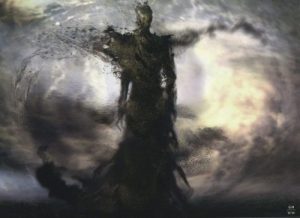
5: Sauron In Númenor. When the Númenórean army arrives in Middle-earth, bringing an end to the war between Sauron and the Elves, Sauron realizes at once that he is outnumbered. But Sauron is cunning: pretending to be defeated, he willingly surrenders to the Númenórean king and commander, Ar-Pharazôn, and is subsequently taken back to Númenor to be a prisoner. Here, he pulls the same trick he used against the Elves: he promises Ar-Pharazôn his greatest desire – in this case, everlasting life. This, he claims, can only be won if Ar-Pharazôn musters the courage and the army to invade Valinor, the Blessed Realm of the Valar. Ar-Pharazôn, not known for being the brightest Edain in Arda, finally succumbs to his prisoner’s seduction, and allows Sauron to counsel him in every matter: when Sauron begins the building of his army, the King agrees to it; when Sauron builds a temple to Morgoth and starts practicing bloody human sacrifices there, the King agrees to it; when Sauron sends him off to his death, the King agrees to it, ignoring all the warnings of doomsday that the Valar send his way. He and his army do make it to Valinor, and they even set foot on the Blessed Realm’s shores – and then, in the greatest act of comeuppance ever, the Valar kill him and almost everyone else in Númenor by sending the island hurtling into the ocean abyss and burying Ar-Pharazôn under a mountain. Sauron is temporarily killed in the cataclysmic disaster, and he loses his ability to ever again take a human form.

4: Gondor And Arnor. At this time, the world is remade again by the Valar, and becomes a globe. Oddly, the only effect this has on the Middle-earth map, aside from the complete disappearance of Númenor, is changing one island in the Bay of Belfalas. Coincidentally, it’s in this bay that the next chapter of the Second Age begins, as this is where one small group of battered ships arrives after a long and arduous journey by sea, manned by the Númenórean prince, Isildur, and his brother. Their father, Elendil, gets washed ashore in the far north of Middle-earth. At these two points on the map, these men set up two kingdoms: Gondor in the south, and Arnor in the north. These kingdoms become one vast empire in these last few years of the Second Age, and are united in opposing Sauron. Isildur builds the city of Minas Anor (later changed to Minas Tirith), and plants the sapling of the White Tree of Gondor there. The seven seeing stones, or palantíri, are placed in secure locations around Middle-earth. The tower of Orthanc in Isengard is built. With callbacks like these, who needs hobbits?
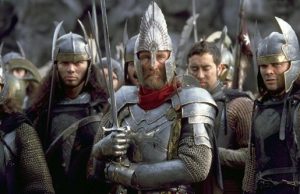
3: The War Of The Last Alliance. Needless to say, Sauron isn’t done haranguing our heroes just yet. Gathering his forces for a final push, he leads his armies of corrupted Ringwraithes, orcs, and foul creatures into battle against the fledgling force of Gondor. But in this dark hour, Mankind does not stand alone. Elendil, King of Arnor, goes to Gil-galad and Elrond and requests their aid: they form a Last Alliance of Elves and Men, and lead their armies together into the south, relieving the siege of Gondor and eventually entering Mordor, Sauron’s dreadful realm. As they approach Mordor, they are joined by Elves out of Lórien and Greenwood, Dwarves from the Misty Mountains, and even Ents out of Fangorn Forest. There are several battles along the way, most notably on the plain of Dagorlad that would later become bogged down and renamed the Dead Marshes. In Mordor, the Last Alliance besieges Sauron’s fortress of Barad-dûr, which lasts for several years.
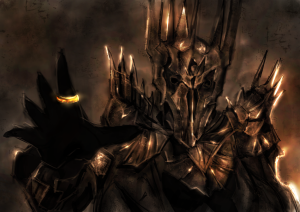
2: The Fall Of Sauron. At last, Sauron breaks the siege, though not before many have died, including Isildur’s brother Anárion and Oropher, king of the Elves of Greenwood. The Dark Lord arrives on the battlefield wearing the One Ring he created, making him almost invulnerable – he drives the attacking armies back to the slopes of Mount Doom, and there, with the fiery heat of his hand, he kills Gil-galad and Elendil. But Isildur, Elendil’s son, takes up the hilt-shard of his father’s broken sword and deals the fatal blow to Sauron, cutting the One Ring from the Dark Lord’s finger. Sauron is vanquished, and his evil spirit flees, incorporeal and weakened. His armies are easily defeated. His Ringwraithes vanish from history. And the war is won. But Isildur refuses to listen to the counsel of Elrond and Círdan, who both advise him to destroy the Ring in the fires of Mount Doom. Instead, Isildur finds himself unable to get rid of the Ring, and holds onto it as a souvenir of his victory.

1: The Disaster Of The Gladden Fields. This one is entirely up to the showrunners: it’s possible they’ll want to end the series on a more hopeful note, with the survivors of the war picking up the threads of their broken lives and moving on, and all that. And certainly there should be some happy endings – but at the same time, it would be deliciously exciting to end the entire series with the disaster of the Gladden Fields, something that was glimpsed briefly in The Fellowship Of The Ring. Isildur, returning home from the war, is attacked by a rogue band of orcs and killed – and the One Ring slips from his finger as he falls and drops into the River Anduin. Imagine it: Howard Shore’s familiar, eerie score closing out the final episode of the final season, as we watch the Ring settle into the mud at the river-bed, there to lie in wait for the next two and a half thousand years…
So what do you think of these ten events from the Second Age timeline? Will they define the series, or do you think the showrunners will focus their adaptation on a singular moment from the chronology, rather than trying to fit three-thousand years worth of story into just five seasons? Share your own thoughts, theories and opinions in the comments below!